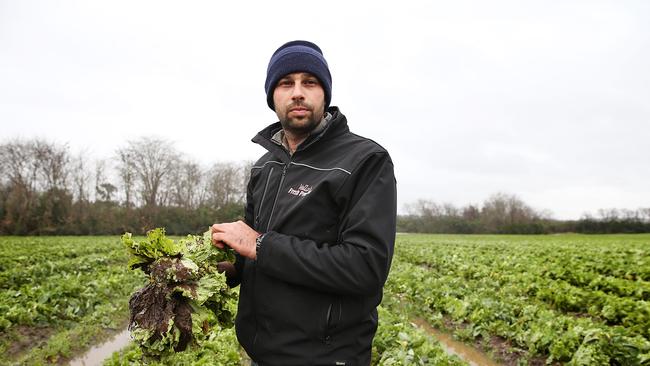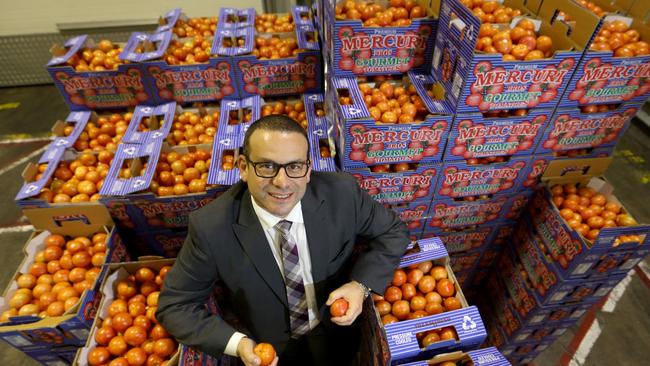In this time of high inflation, some groceries are getting cheaper
The era of the supermarket bargain may have come to the end, but not all fresh produce is rising in price. Here’s why.

After years of benefiting from savage discounting across the country’s major supermarket chains, Australians are now paying more to fill up their grocery trolleys than they did a decade ago.
Devastating floods across key food producing regions in NSW and Queensland, labour shortages, soaring freight costs, and Russia’s invasion of Ukraine has sent the prices of fruit and vegetables hurtling above 7 per cent.
The era of cheap groceries – which began on Australia Day in 2011 when Coles slashed the price of milk to $1 a litre, with Woolworths and Aldi following quickly, angering farmers – has ended.
The supermarket majors this week hiked milk prices to $1.60 and $3.10 for one and two litre cartons respectively. More hip-pocket pain is expected after Australian Food and Grocery Council chief executive Tanya Barden warned Australian shoppers should brace themselves for another 18 months of price rises.
But there are still savings to be found, with not everything triggering sticker shock.
It starts with the much maligned avocado – once a symbol of decadence blamed as the reason Millennials were failing to enter the property market. A national oversupply – after green-eyed farmers planted trees with gusto to cash in the booming market – has pushed retail prices to a record low of $1 each.
Farmers are producing 22 avocados per Australian each year – a 26 per cent increase in the past 12 months. Rabobank associate analyst Pia Piggott says it is just the beginning of what she calls an “avo-lanche”.
Costa Group, Australia’s biggest fruit and vegetable grower and wholesaler, is planting 40 hectares of avocado trees that are faster growing, producing a higher yield and are more water efficient. In the past year, the company’s shares have dived 22.9 per cent to $2.56.

Ms Piggott says it is expected domestic avocado production will surge 40 per cent, or 50,000 tonnes, in the next five years, hitting 173,000 tonnes. “The good news is consumers’ appetite for the likes of smashed avocado and avo smoothies remains healthy, both in Australia and abroad. Australian households are eating more avocados, as well as spending less on them,” Piggott says.
But she adds domestic demand is not enough to lap up the excess supply and farmers will have to look to export markets to preserve their margins. Avocado exports have already surged by more than 350 per cent in the past year, with Singapore, Hong Kong, Malaysia, Japan and the Middle East snapping up the fruit.
“The rise of avocado consumption in Asia – as a growing middle class embraces the health aspects of the fruit – presents an ongoing opportunity for exporters worldwide,” Piggott says.
There is also good news for red meat lovers, with the eastern young cattle indicator – the beef price benchmark – finally slowing, skidding 25.5 per cent from its record high earlier this year.
Beef farmers are on tenterhooks over the outbreak of foot and mouth disease in Indonesia and the potential spread to Australia. Just one local case would shut down key export markets that demand beef products come from foot and mouth disease-free countries, costing Australian beef producers billions of dollars.
Shares in ASX-listed AACo – which owns about 1 per cent of Australia’s land mass – have dived more than 16 per cent in the past month to $1.86. The company’s acting chief executive David Harris said it was engaging with the government and “considering our own mitigation strategies” about the outbreak.
Meat and Livestock director Jason Strong says that there is “clearly … a heightened concern about the impact a potential incursion may have on our industry and this speculative angst is making its way to the saleyards”.
“If we put this aside, there are a number of other sophisticated and tangible market forces putting downward pressure on market prices. These can be broken down into two key categories: on-farm and in the processing sector,” he says. “On farm drivers include supply, mixed quality of livestock presented to market and the fact that the market is performing in typical winter fashion. With a comparatively wet and colder winter, the mixed quality of cattle supplied into the system is also impacting the price.

Prices for another popular protein, salmon, have also eased from a record. The Nasdaq Salmon Index, which tracks the prices of the fish from Norway, the world’s leading producer, has tumbled 36.4 per cent in the past quarter. Rabobank said “recessionary dynamics resulting from a decline in disposable incomes” had sparked a shift toward retail from food service. “For most supplier regions, and especially Norway, supply in (the first half of) 2022 was weak, resulting in a global contraction of 6 per cent, the highest negative supply growth since 2016,” Rabobank wrote in its latest update.
At the same time, Rabobank says production costs are “persistently high” and will remain so for the next six months.
Rabobank senior analyst Michael Harvey says there are emerging signs of changed consumer behaviour in response to cost-of- living pressures, including trading down in food types and reduced spending on discretionary items.
But he said there were a number of factors still exerting upward pressure on food prices, both globally and locally, including flooding and unfavourable weather.

And weather still is one of the main barometers in the pricing of agriculture products – whether it's the floods pushing the price of iceberg lettuce beyond $12 each, or drought and frost in California which has kept the price of almonds high at a time Australian producers, like Select Harvests, a facing a pollination crisis from the varroa mite outbreak.
Costa blamed the wild weather in the Riverland and Sunraysia, which has damaged its oranges at a time when demand in China and other key markets is strong, driving prices up almost 60 per cent in the past year.
But Anthony Di Pietro, chief executive of the LaManna Premier Group – one of Australia’s biggest private fruit and vegetable companies – says producers need to focus on what they can control to boost supply and stabilise prices. And that starts with access to labour. “We can make a significant impact on supply security going forward,” he adds.





